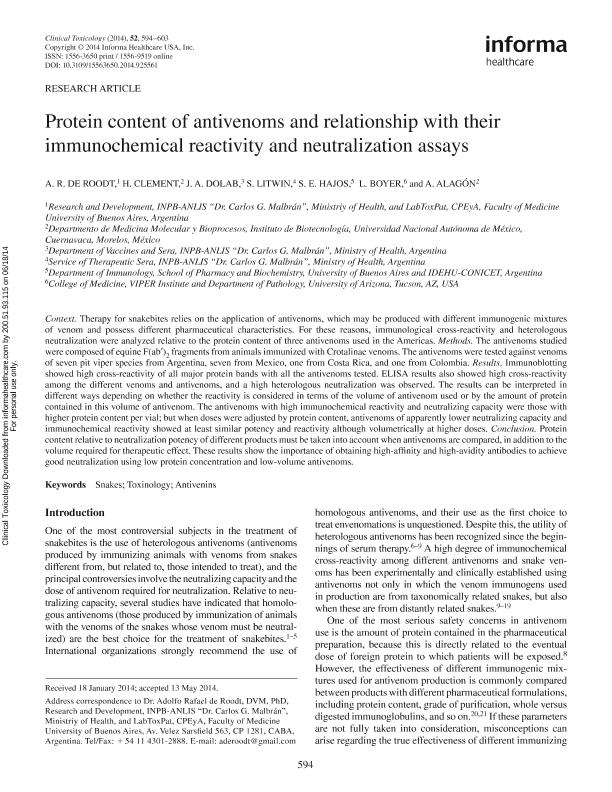Mostrar el registro sencillo del ítem
dc.contributor.author
de Roodt, Adolfo Rafael

dc.contributor.author
Clement, H.
dc.contributor.author
Dolab, Juan Gabriel

dc.contributor.author
Litwin, Silvana

dc.contributor.author
Hajos, Silvia Elvira

dc.contributor.author
Boyer, L.
dc.contributor.author
Alagón, A.
dc.date.available
2017-12-15T14:19:48Z
dc.date.issued
2014-07
dc.identifier.citation
Alagón, A.; Boyer, L.; Hajos, Silvia Elvira; Litwin, Silvana; Dolab, Juan Gabriel; Clement, H.; et al.; Protein content of antivenoms and relationship with their immunochemical reactivity and neutralization assays; Taylor & Francis; Clinical Toxicology; 52; 6; 7-2014; 594-603
dc.identifier.issn
1556-3650
dc.identifier.uri
http://hdl.handle.net/11336/30733
dc.description.abstract
CONTEXT: Therapy for snakebites relies on the application of antivenoms, which may be produced with different immunogenic mixtures of venom and possess different pharmaceutical characteristics. For these reasons, immunological cross-reactivity and heterologous neutralization were analyzed relative to the protein content of three antivenoms used in the Americas.
METHODS: The antivenoms studied were composed of equine F(ab')2 fragments from animals immunized with Crotalinae venoms. The antivenoms were tested against venoms of seven pit viper species from Argentina, seven from Mexico, one from Costa Rica, and one from Colombia.
RESULTS: Immunoblotting showed high cross-reactivity of all major protein bands with all the antivenoms tested. ELISA results also showed high cross-reactivity among the different venoms and antivenoms, and a high heterologous neutralization was observed. The results can be interpreted in different ways depending on whether the reactivity is considered in terms of the volume of antivenom used or by the amount of protein contained in this volume of antivenom. The antivenoms with high immunochemical reactivity and neutralizing capacity were those with higher protein content per vial; but when doses were adjusted by protein content, antivenoms of apparently lower neutralizing capacity and immunochemical reactivity showed at least similar potency and reactivity although volumetrically at higher doses.
CONCLUSION: Protein content relative to neutralization potency of different products must be taken into account when antivenoms are compared, in addition to the volume required for therapeutic effect. These results show the importance of obtaining high-affinity and high-avidity antibodies to achieve good neutralization using low protein concentration and low-volume antivenoms.
dc.format
application/pdf
dc.language.iso
eng
dc.publisher
Taylor & Francis

dc.rights
info:eu-repo/semantics/openAccess
dc.rights.uri
https://creativecommons.org/licenses/by-nc-sa/2.5/ar/
dc.subject
Antivenoms
dc.subject
Immunochemical Reactivity
dc.subject
Neutralization Assays
dc.subject
Snakes
dc.subject
Toxinology
dc.subject
Antivenins
dc.subject.classification
Otras Ciencias Biológicas

dc.subject.classification
Ciencias Biológicas

dc.subject.classification
CIENCIAS NATURALES Y EXACTAS

dc.title
Protein content of antivenoms and relationship with their immunochemical reactivity and neutralization assays
dc.type
info:eu-repo/semantics/article
dc.type
info:ar-repo/semantics/artículo
dc.type
info:eu-repo/semantics/publishedVersion
dc.date.updated
2017-12-14T13:49:36Z
dc.identifier.eissn
1556-9519
dc.journal.volume
52
dc.journal.number
6
dc.journal.pagination
594-603
dc.journal.pais
Reino Unido

dc.journal.ciudad
Londres
dc.description.fil
Fil: de Roodt, Adolfo Rafael. Dirección Nacional de Instituto de Investigación. Administración Nacional de Laboratorio e Instituto de Salud; Argentina
dc.description.fil
Fil: Clement, H.. Universidad Nacional Autónoma de México; México
dc.description.fil
Fil: Dolab, Juan Gabriel. Dirección Nacional de Instituto de Investigación. Administración Nacional de Laboratorio e Instituto de Salud; Argentina. Consejo Nacional de Investigaciones Científicas y Técnicas. Oficina de Coordinación Administrativa Houssay. Instituto de Estudios de la Inmunidad Humoral Prof. Ricardo A. Margni. Universidad de Buenos Aires. Facultad de Farmacia y Bioquímica. Instituto de Estudios de la Inmunidad Humoral Prof. Ricardo A. Margni; Argentina
dc.description.fil
Fil: Litwin, Silvana. Dirección Nacional de Instituto de Investigación. Administración Nacional de Laboratorio e Instituto de Salud; Argentina
dc.description.fil
Fil: Hajos, Silvia Elvira. Consejo Nacional de Investigaciones Científicas y Técnicas. Oficina de Coordinación Administrativa Houssay. Instituto de Estudios de la Inmunidad Humoral Prof. Ricardo A. Margni. Universidad de Buenos Aires. Facultad de Farmacia y Bioquímica. Instituto de Estudios de la Inmunidad Humoral Prof. Ricardo A. Margni; Argentina
dc.description.fil
Fil: Boyer, L.. University of Arizona; Estados Unidos
dc.description.fil
Fil: Alagón, A.. Universidad Nacional Autónoma de México; México
dc.journal.title
Clinical Toxicology

dc.relation.alternativeid
info:eu-repo/semantics/altIdentifier/url/http://www.tandfonline.com/doi/abs/10.3109/15563650.2014.925561?journalCode=ictx20
dc.relation.alternativeid
info:eu-repo/semantics/altIdentifier/doi/http://dx.doi.org/10.3109/15563650.2014.925561
Archivos asociados
